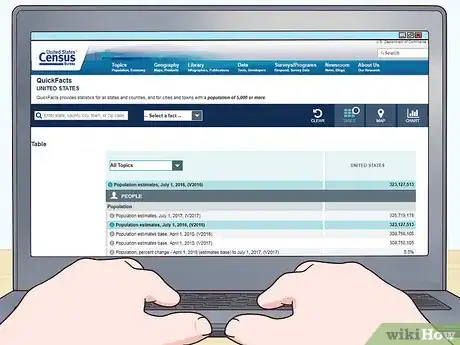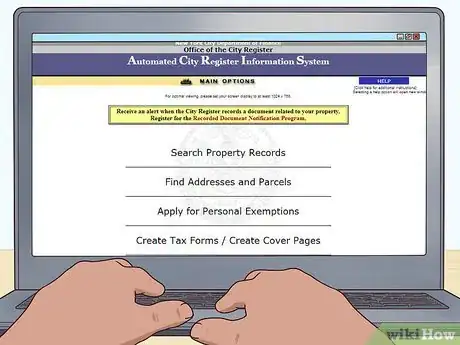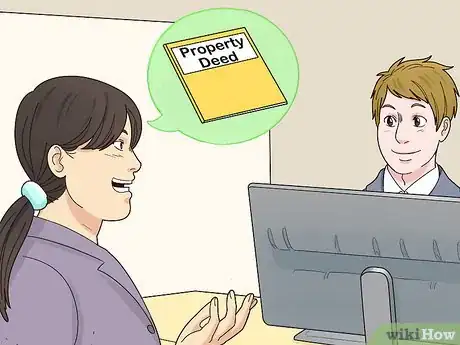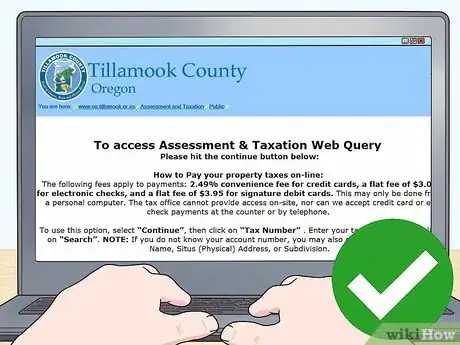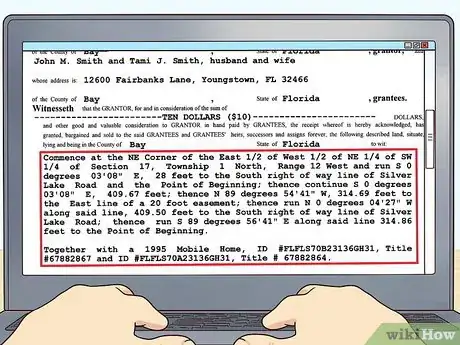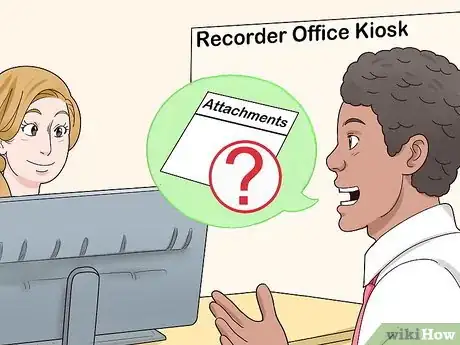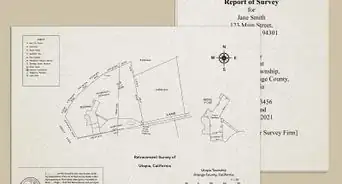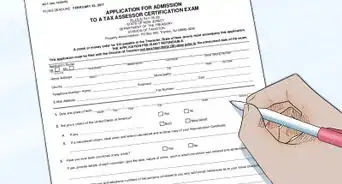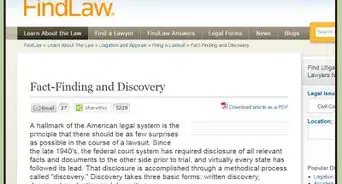This article was co-authored by Clinton M. Sandvick, JD, PhD. Clinton M. Sandvick worked as a civil litigator in California for over 7 years. He received his JD from the University of Wisconsin-Madison in 1998 and his PhD in American History from the University of Oregon in 2013.
This article has been viewed 264,612 times.
A “legal” description of property identifies the particular parameters of a piece of a property and is a critical component of sales contracts, deeds, and mortgages. These legal descriptions identify property so that it may be conveyed, assessed, and taxed. For these reasons, it is important for property owners or prospective buyers to know how to find the legal description of property.
Steps
Finding a Copy of Your Property Deed
-
1Locate the appropriate government office. A copy of your deed is kept at the local county recorder or assessor’s office where the land is located. To locate your county, visit here and enter into the search engine the city, town or zip code of where the land is located.
- After identifying your county, use your preferred internet search engine to find the website for your county recorder or assessor’s office.
-
2Contact the agency. Ask how you can get a copy of a property deed. In some instances, the agency may direct you to an online searchable database.
- For example, the City of New York allows users to search for property records online using its “Automated City Register Information System (ACRIS).”[1]
Advertisement -
3Request the deed in person. If you can't find a deed online, then request it in person at your local recorder or assessor’s office.
- You may have to pay a fee. In large cities, the cost could run from $2.25 per page in Washington, D.C., to $4 per page for a certified copy in New York City.
- In smaller towns you may pay less. Piscataquis County, Maine provides the first 500 pages free. After that, you pay 50 cents a page.[2]
-
4Contact a third party. Typically, when a deed is recorded with the county, a copy is returned to the buyer's agent.[3] If you are the property owner and have misplaced or never possessed the property deed, you can contact the real estate agent, lawyer or title company who processed your closing to get a copy.
-
5Use property tax statements. The legal description of a particular piece of property may also be located on the annual property tax statements prepared by the city or county tax assessor’s office. For instance, the property tax statements prepared by the Tillamook County, Oregon, Assessor’s office may contain the legal description of the property.[4]
- Not all jurisdictions include the legal description of property on tax statements.[5]
- Any description contained may not necessarily be the “legal” description. Clarify with your city or county assessor’s office that the description contained on the tax statement is the “legal” description of the property before relying on it to make important transactions.
Identifying the Legal Description
-
1Look at the deed. The deed will often be captioned “Land Deed,” “Property Deed” or “Warranty Deed” at the top (although it does not have to be).
-
2Find the legal description of property. The date and the names of the parties to the transaction come first, then the legal description. Look for the words “legal description” or just “description.” There are generally two types of legal descriptions: (1) subdivision description or (2) metes and bounds.[6]
- If the property is part of the subdivision, the description will name the subdivision and list the lot number. You can find the plat map for a subdivision at the same county office that you found your deed.
- A metes and bounds legal description will situate the property according to points of reference, such as landmarks. A metes and bounds description will typically begin by telling an observer where to start: “Commence at southeast corner of the east half of Section 12, Township 4” or words to that effect.
-
3Find any attachment or appendix. Sometimes, the legal description is included as an attachment. You will be told this on the face of the deed, under legal description. Typically, you will see language such as “see attachment A” or “property described in exhibit A.” The exhibit is attached to the deed.[7]
- If you do not have the attachment, you likely did not get it at the recorder’s office. You should return and ask someone to help you find the attachment. Bring your copy of the deed to show the person what you are referring to.
-
4Note any inaccuracies in the deed. If you notice an error in the deed, such as the wrong subdivision lot listed, then the deed needs to be corrected.
- To legally correct a deed, it needs to be re-executed by the original grantor, complete with proper notarization and witnessing. Then, the corrected deed must be recorded.[8] It's not enough to simply attach a corrected description to the deed and then file it.
- If a deed needs to be corrected, seek legal counsel. It is important that the deed be properly drafted.
References
- ↑ http://www1.nyc.gov/nyc-resources/faq/378/how-do-i-get-a-copy-of-a-property-record-or-deed
- ↑ http://www.piscataquis.us/deeds
- ↑ http://www.realsimple.com/home-organizing/organizing/record-keeping/replace-store-important-documents/get-copy-property-deed
- ↑ http://www.deedclaim.com/legal-description/
- ↑ http://www.deedclaim.com/legal-description/
- ↑ http://www.deedclaim.com/legal-description/
- ↑ http://www.deedclaim.com/legal-description/
- ↑ http://www.shuffieldlowman.com/a-defective-deed-now-what/
About This Article
To get a legal description of property, start by contacting the local county recorder or assessor’s office and asking how you can get a copy of a property deed. If you’re the property owner and have misplaced the deed, you can contact the real estate agent, lawyer, or title company who processed your closing to get a copy. Once you receive the property deed, look at it to find the legal description and note if there are any inaccuracies. Additionally, the legal description of a piece of property may also be on the annual property tax statements. To learn how to legally correct a mistake in a deed, keep reading!
